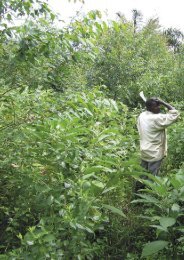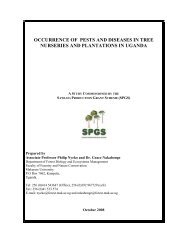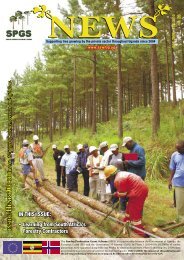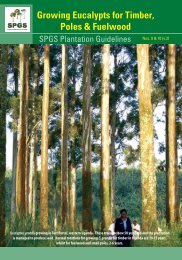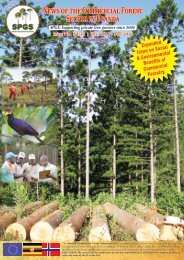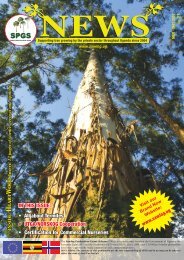download - SPGS
download - SPGS
download - SPGS
You also want an ePaper? Increase the reach of your titles
YUMPU automatically turns print PDFs into web optimized ePapers that Google loves.
HeartWood No. 1 (2009)<br />
conclusion. It is acknowledged, of course that<br />
the result is an interim one to be confirmed<br />
later in the rotation with volume assessments.<br />
Also worth noting is that this satisfactory<br />
outcome helps to ensure that the cost of<br />
wood production remains amongst the lowest<br />
in the world (Horrell, 2001).<br />
In view of the intensive management of the<br />
highly productive plantations on the relatively<br />
poor soils at Usutu, namely short rotations,<br />
no thinning, and a clearfelling silvicultural<br />
system, to name but three, the data reported<br />
here augur well for the sustainability (narrowsense)<br />
of plantations more generally. This is<br />
important since planted forests are destined<br />
to play an ever-increasing role in global wood<br />
supply.<br />
About the Author: Professor Julian<br />
Evans is a highly respected person in<br />
tropical forestry, perhaps best known<br />
as the author of the standard text<br />
- Plantation Forestry in the Tropics.<br />
Julian has worked or studied plantations<br />
in some 30 countries and has authored<br />
over 120 scientific and technical papers.<br />
From 1997 to 2007, he was Professor<br />
of Tropical Forestry at Imperial College,<br />
University of London. He visited<br />
Uganda for the first time in 2009 on a<br />
consultancy for Uganda Gatsby Trust<br />
(which is how he appears on the cover of<br />
News 24!).<br />
Prof, Evans signing copies of his Plantation<br />
Forestry book at the <strong>SPGS</strong> offices in Feb.<br />
2009. Copies available for only UGX.<br />
150,000/=<br />
THE FUTURE OF PLANTATIONS<br />
From my perspective - By Evan D. Shield<br />
Introduction<br />
In these early weeks of 2009, it would seem<br />
only common sense that any consideration of<br />
global problems should focus on the financial<br />
crisis. That crisis is lamentable, undoubtedly<br />
severe in its impacts and of uncertain duration.<br />
However, the focus of this contribution is on<br />
another set of global problems and their<br />
combined impact on plantation forestry. In all<br />
probability, at a global scale, these problems<br />
have potentially greater durability and severity<br />
than the financial crisis.<br />
Problems for Plantations<br />
This set of global problems arises through<br />
the impacts, probably cumulative, of global<br />
warming, population growth, peak oil, a<br />
developing scarcity of phosphorus and ongoing<br />
land degradation.<br />
In brief :<br />
• global warming is claimed to have the<br />
potential to cause higher temperatures,<br />
lower precipitation and increasing<br />
frequencies of extreme climatic events such<br />
as droughts, floods, frosts and heat-waves.<br />
In addition, rising sea-levels are forecast.<br />
Basically, many now productive lands will be<br />
less able to carry economically competitive<br />
crops 1 ;<br />
• today’s global population is estimated at<br />
6.76 billion 2 and, by 2050, it is anticipated<br />
to be 9 billion 3 , an increase of 33 %. By<br />
2050, 58.6 % of this 9 billion will live in<br />
Asia and 20.2 % in Africa. These continental<br />
areas already have regions wherein there are<br />
large populations of severely marginalized<br />
people ;<br />
• peak oil means that – notwithstanding<br />
its recent dramatic declines – the price<br />
of oil and other fossil fuels will rise when<br />
demand again accelerates as the world’s<br />
financial wounds are healed and confidence<br />
is re-established. It is also noteworthy that<br />
direct or indirect taxes on carbon dioxide<br />
emissions to mitigate global warming<br />
impacts will have the effect of increasing<br />
fossil fuel prices. Additionally, peak oil<br />
will continue to encourage acceleration<br />
in production of bio-fuels, many of which<br />
appear to be produced at the expense of<br />
food and feed for, respectively, direct and<br />
indirect human nutrition. This occurs in<br />
the context of there being almost 1 billion 4<br />
undernourished people in today’s world,<br />
including 209 million children whose diets<br />
are so inadequate that they are physically<br />
stunted 5 ;<br />
• there is a growing concern that energy<br />
costs were not alone in driving the cost<br />
of phosphate fertilizers (such as superphosphate,<br />
MAP and DAP) to such high<br />
levels in 2007 and 2008. Serious research<br />
is now suggesting that production of<br />
these fertilizers is also approaching a peak<br />
because of a global scarcity of phosphate<br />
rock 6 . Significantly, phosphorus is one<br />
of three critical elements for Eucalypt<br />
plantation success (together with boron and<br />
potassium) and its deficiency in soils used<br />
for plantations is also common 7 . Moreover,<br />
presently, there is no practical potential to<br />
substitute for production of this fertilizer,<br />
commercial volumes of which are derived<br />
exclusively from mined phosphate rock.<br />
• mankind treats this earth badly. The<br />
chart below indicates how degradation 8<br />
and population growth have combined to<br />
diminish the area of land on which each of<br />
us depends for food, feed, fuel and fibre.<br />
Unfortunately, degradation is anticipated<br />
to continue and, in combination with the<br />
impacts of global warming and population<br />
growth, to reduce further the availability per<br />
caput of arable land. For example, Professor<br />
Rattan Lal 9 is quoted to have estimated<br />
that, by 2050, all the necessities of food,<br />
feed, fibre and fuel for each person on the<br />
earth must be met from an average of only<br />
about 405 square metres of land (20 m. x<br />
20 m.). He said: “Because we have already<br />
degraded a lot of available land, unless there<br />
is successful restoration of some of that land,<br />
we will simply run out of land”.<br />
1<br />
For a scholarly analysis, refer to Cline, William R. : Global Warming and Agriculture – Impact Estimates by Country, 2007, published by the<br />
Center for Global Development and the Peterson Institute for International Economics.<br />
2<br />
This estimate for the end of January 2009 is from the U.S. Census Bureau<br />
3<br />
According to the United Nations projections<br />
4<br />
FAO estimated that there were 923 million malnourished people in 2007 and The Guardian newspaper reports that this number increased by<br />
40 million in the course of 2008. In their report: The State of Food Insecurity in The World, 2008, FAO stated that increasing food prices were<br />
largely responsible for this situation.<br />
Note that FAO’s data is based on protein / calorie malnourishment. If dietary deficiencies in iron, iodine and vitamins A. B, C and D are added,<br />
the malnourished population totals 3.7 million, as reported by the World Health Organization (2005). It is WHO data that is used in reference 10<br />
in this paper, resulting in it being quoted to the effect that nearly 60 % of the global population is malnourished.<br />
5<br />
Refer : www.theglobaleducationproject.org/earth/human-conditions.php<br />
6<br />
Refer to the web-site : www.phosphorus-futures.net<br />
7<br />
Refer to Silveira et al : Evaluation of the Nutritional Status of Eucalypts : Visual and Foliar Diagnoses, Chapter 4., page 85 in Forest Nutrition<br />
and Fertilization, ed. by José Leonardo de Moraes Gonçalves and Vanderlei Benedetti, published by the Institute of Forest Research and Study<br />
(IPEF), Piracicaba, São Paulo, 2004.<br />
8<br />
Causes of degradation vary significantly. Deforestation is the prime cause of land degradation in South America, Europe and Asia ; poor<br />
agricultural practices in North and Central America and overgrazing in Oceania and Africa.<br />
9<br />
Rattan Lal is a professor at the School of Natural Resources, College of Food, Agricultural and Environmental Science, Ohio State University,<br />
U.S.A.. This reference to his work is from an article in The Boston Globe by Drake Bennett, 29th. April, 2008. Professor Lal referred to an area<br />
of 1/10 of an acre, which is equivalent to 405 square metres.<br />
3



